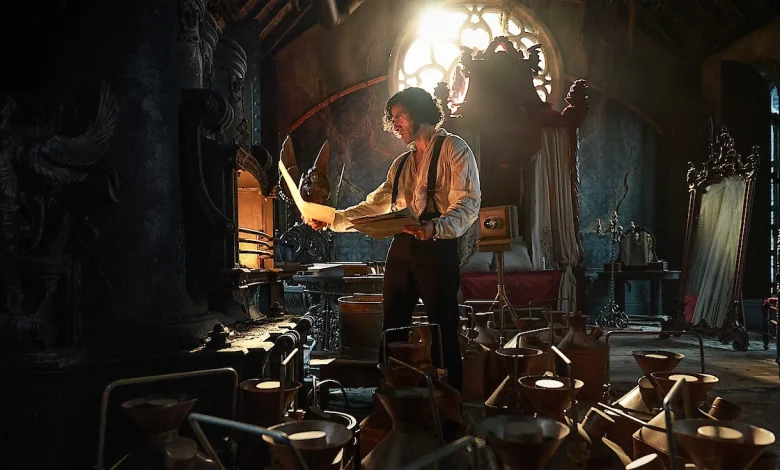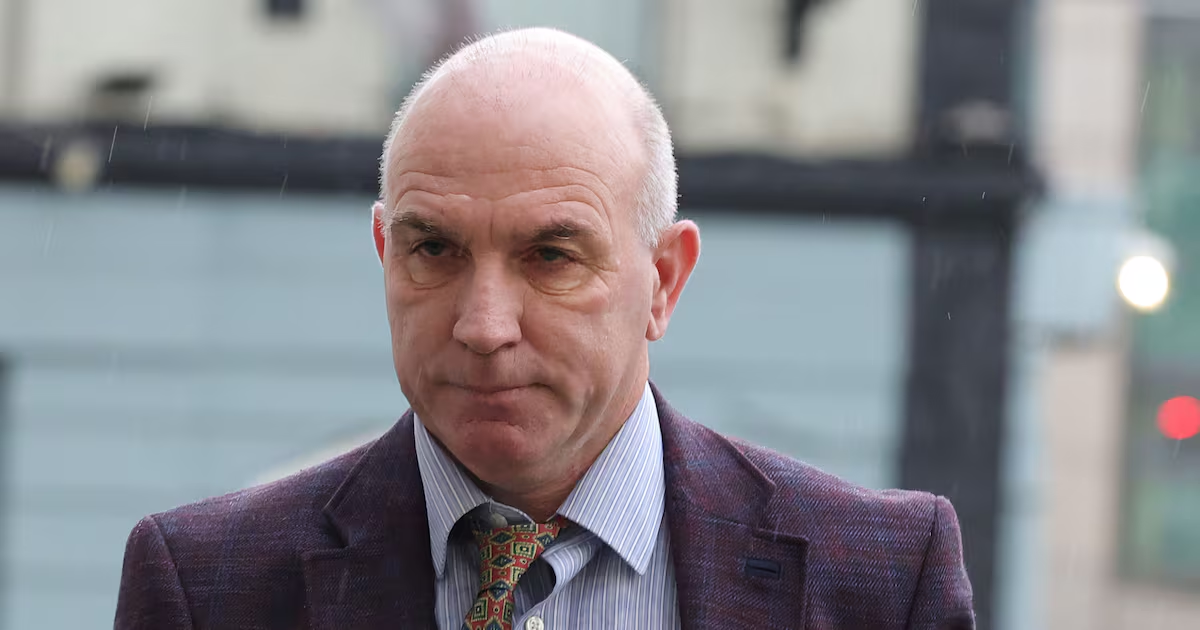Dissect the Emotional Ending of Frankenstein

This article contains major character or plot details.
“What manner of creature is that?” Captain Anderson (Lars Mikkelsen) asks during the prelude of Guillermo del Toro’s lavish new Frankenstein adaptation. “What manner of devil made him?”
Both questions are at the heart of del Toro’s new film, one that he’s been aching to make since childhood. They’re also the inciting ideas of Mary Shelley’s seminal 1818 novel, Frankenstein; or, The Modern Prometheus, a book del Toro worships above all others. “I lived with Mary Shelley’s creation all my life,” del Toro tells Netflix. “For me, it’s the Bible.”
While Shelley’s novel has inspired myriad interpretations over its centuries of existence — “It has endless possibilities,” Oscar Isaac, who plays Victor Frankenstein, tells Netflix — del Toro’s relationship with his “Bible” is intensely personal. He aspired to make the story his own, choosing an angle of adaptation near and dear to his heart.
In del Toro’s hands, Frankenstein is reborn as a story of two lost souls, irrevocably intertwined by the facts and pain of their own creation. In its broad strokes, it remains loyal to Shelley’s text; the frozen prelude in particular is drawn directly from the book. But del Toro’s personal fixations bleed through his monster’s scars. “I wanted to sing it back in a different key and with a different emotion,” the filmmaker says. “The backbone of it became a story about a father and a son and what it is to become a father after being a son.”
For Jacob Elordi, who plays the Creature, del Toro’s adaptation gets at the heart of Frankenstein. “Frankenstein is the gothic fairy tale,” the actor tells Netflix. “And Guillermo has sucked the essence out of the text in terms of family; in particular, father-son relationships. For me, the film is a conversation with your father, the archetypal father-son relationship.”
You have the chance to listen in on that conversation in Frankenstein, now streaming on Netflix, and here, as the cast and crew tell us how they assembled del Toro’s definitive creation.
Who is Captain Anderson in Frankenstein?
Frankenstein opens on a frozen tundra, where a crew of Danish sailors are chipping away at the Horisont, an icebound ship. Overseeing them is Captain Anderson, a fearless explorer desperate to reach the North Pole. Asked by a subordinate if he’d consider turning around, Anderson is ruthlessly firm: The Horisont will continue to sail for the horizon, no matter the cost.
That cost proves surprisingly high. When Anderson hears an explosion, the crew discovers a frostbitten, one-legged man surrounded by a halo of blood: Victor Frankenstein. When he’s brought aboard the ship, a towering figure emerges from the icy landscape, shouting for Victor. It charges for the vessel, savaging sailors and shrugging off bullets with ease. This is the Creature, a seemingly invincible being who’s pockmarked with scars and strong enough to move the ship itself. Anderson dispatches the Creature (albeit briefly) by shooting out the ice under his feet with a blunderbuss, and the captain turns to interrogate Victor. What manner of devil made him? I did.
Shelley’s version of Anderson is named Robert Walton, but the thrust of the character is the same: a seemingly unfeeling pioneer, powering through the ice with no regard for the safety of those around him. “You start with the captain, his back to the sun as it rises, because that captain is a surrogate for Victor,” del Toro says. As Victor tells Anderson later in the film, “You share my sickness.” Both men are victims of their own success, determined to chase glory regardless of the cost for others.
Del Toro wanted the film’s prelude to feel real and not real, all at the same time. “There’s a limbo feel to the prologue in the Danish ship trapped in the ice,” he says. “I wanted it to feel like an old movie that was made in the heyday of Hollywood. I wanted it to be luscious and beautiful and operatic and all that. I wanted a real ship and when the creature moves it, I wanted the creature to move it.” To accomplish this, the production built the ship on a mechanical gimbal that was capable of rocking back and forth.
“If you do it for real, people have a sense,” del Toro says. “So we did the ship for real, complete. Interior, exterior, everything.” That commitment to verisimilitude is a quality del Toro shares with Victor, who spins his tale of handmade horror for Captain Anderson.
What happened to Victor’s mother?
In del Toro’s film, Victor’s story starts at the very beginning, when he was a young boy (Christian Convery) growing up on the vast Frankenstein estate. He’s close with his mother, Claire, and distant from his abusive father, Leopold — two relationships that will haunt him the rest of his life. Played by Charles Dance, Leopold is the foremost surgeon of his time, a frosty titan who ruthlessly drills Victor’s surgical knowledge and punishes him with lashings to the face when he’s incorrect.
The bookend to Leopold’s cruelty is Claire, who’s played by a familiar Frankenstein face: Mia Goth, who later in the film will also play the role of Elizabeth, Victor’s prospective sister-in-law and romantic fixation. “I needed the same actor that plays the mother to play Elizabeth,” del Toro says. “Many men fall in love with their mothers, but they don’t realize it, in a primitive Freudian way.”
To distinguish the two characters, Goth wore light prosthetics to play Claire, and spoke only French. She also wore a thin red veil, part of del Toro and cinematographer Dan Laustsen’s color theory for the film. “The mother and the home are red,” del Toro says. “So if Victor loses that, that’s the color that should haunt him the rest of the movie. He’s the only character that wears red; red gloves, red scarf. The red chases him through the movie.”
When Elizabeth dies in childbirth, Victor blames his father for failing to save her, and turns to his “guardian angel,” an imagined figure of fire and death who coaxes him towards his ultimate goal: to conquer death itself. It’s a motive drawn from both Victor’s mother’s death and his perceived failure of his father to save her.
“I wrote it for [Dance], and he said, ‘Oh, this is an unlikable man,’ ” del Toro recalls. “And I said, ‘Yeah, but he is the Big Bang.’ ” Leopold’s influence chases Victor as he reaches further and further past the conventional wisdom of his educators and peers. He is desperate to be greater than his father was, to cross the threshold of science and conquer death itself.
What are Evelyn tables? Are they real?
The film flashes forward to an adult Victor, who has split off from his younger brother, William (Felix Kammerer), Leopold’s favored ray of sunshine to Victor’s solitary storm cloud. Before a tribunal of the Royal Society of Medicine, Victor is demonstrating a shocking experiment: a recently deceased corpse that he has reanimated with galvanic batteries. Society elders scoff at Victor’s experiments, pronouncing them carnival tricks. He insists there’s more to it than that, tossing a ball to the corpse, who catches it. But it’s not enough to save Victor from the small minds of his colleagues. He turns the corpse’s power off and stalks out of the room.
Enter Heinrich Harlander (Christoph Waltz), a wealthy arms dealer with a surgical background. He comes bearing a letter from William, who is planning to visit Victor with his fiancée, Harlander’s niece Elizabeth. But Harlander has ulterior motives; he witnessed Victor’s experiment, and it piqued his interest. He offers Victor an opportunity to work under his patronage, asking only for a future favor in return. And there’s an added bonus: Harlander has in his possession the fifth Evelyn table.
The Evelyn tables are real — although the fifth is a fictional addiction to the story of Frankenstein. Early anatomical preparations from the 1640s, the Evelyn tables were the result of careful dissections of real human bodies, lacquered onto wooden boards to allow for scientific study. The four existing tables depicted, respectively, the spinal cord and nerves; the aorta and distribution of the arteries; the vagi, sympathetic nerves, and the veins of the lungs and liver; and the distribution of veins. All four are currently on display at the Royal College of Surgeons of England’s Hunterian Museum in London.
Del Toro’s film imagines a fifth, representing the lymphatic system: the key to Victor’s quest to keep galvanic energy flowing, thus reanimating a body.
What happens when Victor meets Elizabeth?
Victor is quickly distracted from his work for Harlander by Elizabeth, who pushes back on his convictions with an intoxicating intensity. “I see Elizabeth as a butterfly or a moth, and she’s fluttering and trying to find her place in this world,” Goth tells Netflix. Initially, she seems hostile to Victor, but when he smuggles himself into her confessional booth at church, the pair begin a tantalizing almost-courtship.
As Elizabeth flutters about, however, she has other ideas. She rejects Victor’s amorous advances — and he pours himself into his work in response, collecting body parts from condemned men and determining how to properly harness galvanic energy to bring his exquisite corpse to life. Harlander sets a deadline; the Crimean War he is profiting from is drawing to a close, and a final battle will provide all the arms and legs Victor needs.
Del Toro consciously tried to make this section of the film an ode to joy, rather than an ominous march. “The way that he builds the creature, I wanted it to be very joyous,” del Toro says. “Everybody does the creation of a monster like a stormy, scary thing, and I wanted him to have fun cutting, mixing, matching all those parts.”
What does Harlander want from Victor?
Of course, the storm is still approaching. As Victor completes the puzzle of the Creature, Harlander finally asks for his favor. The wealthy dandy is dying of syphilis, and he wants Victor to place his decaying brain in the Creature’s towering patchwork body. “Is [Harlander] this villainous character?” Isaac says. “Actually, no, he ends up being this kind of heartbreaking person who’s just looking to just live a little bit longer.”
Victor refuses, but Harlander won’t take no for an answer; he chases his protegé to the roof of the tower and begs for Victor to save him. But the scientist stands firm: The disease has spread too far, and every part of Harlander’s body is now contaminated. In a final desperate gambit, Harlander threatens to destroy the priceless silver conductor that will electrocute the corpse. The two men struggle, and Harlander falls to his death.
After death comes life. “I filmed two concerts in the movie,” del Toro says. “One concert is him like a rock star in the middle of the medical class, moving around like Keith [Richards] or Mick [Jagger], really doing a concert for the younger medics. And the second is the creation of the monster.” Del Toro told Isaac to look to conductor Leonard Bernstein and keyboardist Rick Wakeman of the prog rock band Yes for physical inspiration; Victor spins around the tower pulling levers and ratcheting the Creature into position on a table shaped like a crucifix. Lightning strikes, and the towering batteries around Victor are drained. But the Creature doesn’t move.
Why does Victor burn the tower down?
Hours later, Victor bolts upright in his bed. A towering, bandaged figure is looming at the foot of his bed. It’s the Creature — alive after all. He imitates Victor in a childlike manner, moving left to right and basking in the sun, arms out.
Elordi’s physicality in the role is far more delicate than the traditional interpretation of Frankenstein’s monster. “I studied Butoh in Toronto, which is like the dance of reanimating a corpse,” Elordi says. “You have to close your ears off and close your nostrils off and close your eyes off and change the way that you see things, the shapes of things. They all take on a new life.”
The Creature is living a new life, and he soon learns a new word: Victor. At first delighted by this development, Victor soon grows to resent it. Beyond his miraculous ability to heal and grow stronger, the Creature seems to be making little intellectual progress. Victor manacles him in the watery basement of the tower and mocks his childish emotions. Victor, like his father, has become a harsh, cruel man.
Isaac sees Victor’s attempt at fatherhood as part of a tragic cycle. “For me, the theme of father and sons, and the pain and the damage that continues as a cycle is a big theme,” he says. “How that trauma gets passed on and passed on and the reaction to that and how the fracturing of a human being plays into it.”
Because the Creature is a human being, even if Victor can’t quite see it. Others can. When Elizabeth and William come to visit, Elizabeth forges an instant and profound connection with the Creature. “She’s capable of seeing the unvarnished beauty of a pure soul in the monster,” del Toro says. “Where Victor sees disappointment, she sees promise. And I think that’s love. Love is the capacity to see promise where before there were disappointments.”
Elizabeth teaches the Creature her name, and he gives her one of the leaves he’s grown fascinated with. “She understands him, and she just knows, [like] ‘I see you,’ ” Goth tells Netflix. “ ‘I may not look like you, but I feel like you.’ That was a big point for me.”
Victor, meanwhile, continues to fall further. He lies to William, telling him that the Creature killed Harlander in a fit of rage. He scorns the Creature’s intelligence. It’s not ready yet, he insists. Not even a letter from the Royal Society of Medicine, inviting him to share the results of his experiment, can shake Victor’s resolve. He sends William and Elizabeth away and resolves to burn the tower to the ground, erasing the experiment he’s grown to resent. But first, Victor gives him the Creature last chance: Say any word other than “Victor,” and he’ll free him.
“Elizabeth,” the Creature whispers. Victor storms away, leaving the tower in flames and ignoring the Creature’s tortured cries. He turns back at the last moment, but it’s too late. The flames fling him from the tower, and Victor is dragged away by William, his leg as shattered as his dreams.
What is the Creature’s story?
Here, the film returns to the Horisont, where Victor’s tale is coming to a close — and the Creature is standing outside the cabin doors. “My maker told his tale,” he intones. “And I will tell you mine.”
As it turns out, the Creature made his escape from the tower just in time, breaking his chains and plunging into the water beneath. Wandering through the woods, he finds a coat on a soldier’s corpse, before running afoul of a pair of hunters. The Creature seeks refuge in an abandoned mill, until the family returns home, hunters in tow.
Through the walls of the cabin, the Creature witnesses a great deal. He sees the family’s blind grandfather (David Bradley) treating his granddaughter with kindness, teaching her words, and reading her stories. The Creature learns these same lessons from a distance. It’s a far cry from Victor’s brutal expectations, and the Creature begins to return the favor, gathering wood for the family and building them a stable. They chalk up these gifts and miracles to a kindly forest spirit, and the Creature continues to live invisibly alongside them in harmony.
When the family leaves for the winter, the blind grandfather stays behind to pray in the cabin, and the Creature forges an even closer connection with him, venturing inside and posing as a weary traveler. He learns to read from the old man, and opens up about the fractured pain he feels as he struggles to remember his past. “He needs to feel like a baby, and then he needs to feel like a philosopher,” del Toro says. “This is one of the salient things that Mary Shelley did in the book and this movie does. We track the growth of the creature into a man.”
The old man in turn tells the Creature about his own past misdeeds, and, recognizing him as the “spirit of the forest,” encourages him to seek out the answers he’s looking for — and, if he can, to forgive those who wronged him.
So the Creature returns to the tower, where he finds in the rubble Victor’s letter from the Royal Society of Medicine, and Harlander’s abandoned photographs of the Creature’s corpse. “I am the child of a charnel house,” he tells the old man upon returning to the cabin, on the verge of monstrous tears. But now the immortal Creature is faced with something he cannot heal: The old man has been wounded, savaged by wolves while the Creature went to reckon with his past. When the rest of the family return, they believe the Creature is responsible for the old man’s death, and shoot him, seemingly fatally.
But the Creature lives again. Desperate to escape his undying solitude, he resolves now to seek out his maker, begging him to forge a companion for him. “We can be monsters together,” the Creature says with a heartbreaking smile. Reality will be harder to handle.
What happens to Elizabeth and William?
The Creature hunts down Victor at the Frankenstein estate, where William is preparing for his wedding to Elizabeth. After having been expelled from Elizabeth’s chambers once again, Victor finds the Creature in his room, and rejects his plea to make another monster. The Creature responds in rage, tossing Victor across the room. When Elizabeth enters, she rushes to the Creature — and is mortally wounded by the bullet that Victor intended to destroy his own creation.
Chaos erupts. William enters the room, only to be hurled to the side by the Creature, who stalks out of the mansion with a dying Elizabeth in his arms. He lays her on a rock in a cavern, and they bid farewell to each other. “She is the one that sees the universe as a gentle, admirable force, and she has compassion and admiration for little things,” del Toro says. That compassion flows from the smallest insect to the largest Creature, and now its light has gone out.
Back at the estate, William’s light is also dimming — but not before he faces his brother one last time. “You are the monster,” he tells Victor with his last breaths. It’s a chilling corrective to the story of Frankenstein, one that’s been debated time and time again in the years since Shelley’s novel was first published. Del Toro, that famous lover of monsters, is blunt in his interpretation. “Like all tyrants, he believes himself to be a victim,” del Toro says. “ ‘Poor me, poor me.’ And in the meantime, the [tyrants are] destroying everybody’s life. That’s Victor.”
Victor sets out to hunt the Creature, determined to travel to the ends of the Earth if necessary, which leads us right back to where our story began: on the ice, where the Creature survives everything his maker can throw at him.
What happens to Victor?
Frankenstein is a film with a wide scope, from a lightning-struck tower to a frozen battlefield. But it comes to a close in a much more intimate setting: back in Captain Anderson’s cabin, where the Creature’s tale has made Victor realize his faults as a creator — as a father. “The first part of the movie is told from the point of view of the scientist, Victor,” del Toro says. “And the second part is when your kids come to you and say, ‘This is what you did wrong.’ And you have an epiphany, and you go, ‘That’s right.’ ”
For Isaac, it’s a moment that threads all the way back to Victor’s tortured origins. “It’s the child that Victor’s been running away from,” Isaac says. “He tries to kill it, and he tries to remake it. ‘Maybe I can make a new version of the child that I was.’ And he makes this thing, and he’s horrified by it.”
In spite of everything, the Creature forgives his father. “In forgiveness is where the Creature learns that he can finally be human,” Elordi says. “The only way he discovers that is not through violence or revenge. It’s through actually seeing another person and understanding them and understanding his father’s flaws and that his father came from somewhere as well.”
Echoing something Elizabeth tells him earlier in the film, Victor asks his son to say his name one last time, the way he did in their first days together. The Creature obliges, and Victor dies peacefully. It’s a scene that recalls the final moments of del Toro’s Pinocchio adaptation, when Geppetto accepts his son for who he is. “They both are stories about ‘abnormal kids’ born to fathers who are disappointed in a way,” del Toro acknowledges.
It’s a story that del Toro has wanted to tell even before he began making movies, and all his films, on some level, draw from his love for Frankenstein. “There’s elements of Frankenstein in Cronos, in The Shape of Water, and Blade II,” he says. “This culminates a cycle.”
What happens to the Creature at the end of Frankenstein?
The Creature’s cycle, too, is coming to a close. Captain Anderson allows him to leave the ship in peace, and, in return, the Creature frees the Horisont from its icy prison. Thinking back on Victor’s story, Anderson tells the crew they’re heading home. The horizon, treacherous as ever, can wait.
As for the Creature, our final glimpse of him rhymes with our very first. He stands in the Arctic sun with arms outstretched, a frozen tear running down his cheek as he basks in the rays of light in the same way his father once taught him to do.
“Frankenstein is about somebody accepting life in the absence of death,” del Toro says, “being blissful any moment you’re alive.” The Creature is alive. Now it’s time for it to live.
Frankenstein is now streaming on Netflix.





